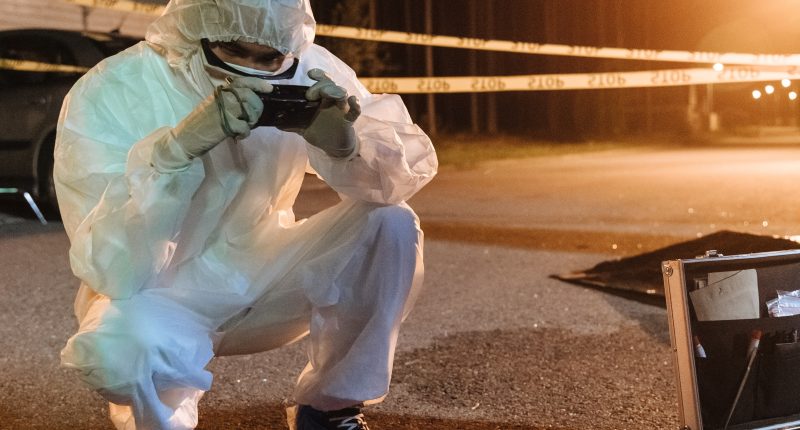The word photography is derived from the Greek word, photos means “light” and graphos means ‘pertaining to drawing or writing’. Thus, photography are often defined as the art, science and practice of creating the images by recording light or other electromagnetic radiations, either chemically by means of a light sensitive material like photographic film, or electronically by means of a sensor.
In crime cases, the documentation of evidence is one among the foremost important stages of any crime scene investigation. Besides others, photography is taken into account together of the important documentation technique in the field of forensic science which may record the entire crime scene area, exact conditions of crime scene and therefore the evidences present over there. Photography is additionally sometimes wont to further enhance the small prints that aren’t being visible to the human eye. The forensic photography section supports the forensic science in generally, but to varied divisions like questioned document; chemistry; toxicology; ballistics; physical section; biological section; DNA and medical examiner’s departments by documenting evidences, and autopsies etc.
The photography section of any laboratory is additionally liable for the planning of displays and graphics for reports to be presented within the court of law, training and therefore the web. So this division is taken into account to be an important part of general crime scene investigation and thereafter within the laboratory. In addition, it’s often utilised in the laboratory to see and store the patterns and phenomena that a while won’t be detectable with eye. This application of photography in Forensic Science is predicated upon the fact that it often wiped out different spectral regions like ultraviolet and infrared.
Photographic Chemistry: In Photographic chemistry, the film and paper was treated with the chemicals after exposing them to light to generate a negative and positive image. This chemical processing transforms the latent image into a permanent visible image. Photographic chemistry was first discovered in 1830 by Louis-Jacques-Mandé Daguerre of France and by Henry Talbot of England.
According to method of Daguerre’s, a silver iodide-coated silver plate was exposed to light in a camera, which decomposed the exposed silver iodide to metallic silver and iodine. A clear permanent image was produced by treating the plate with the vapors of mercury i.e. by amalgamation of the silver. The remaining silver iodide was removed by rinsing it with a strong salt solution.
A positive image appear by holding this “Daguerreotype” in oblique light against a dark background, in order that the amalgamated silver zones appeared bright and therefore the silver plate appeared dark. Photographic film was made up of a nitrocellulose strip. Many layers of silver iodide were also coated – each layer with a different dye. Each dye responds to light of a particular colour.
How an image is formed?
Film was media to record image in cameras. Photographic film was invented in 1727, when Johann Henrich Schulze mixed chalk, silver, and nitric acid during a flask to form nitrate. When this solution was exposed to sunlight, colour changed from white to purple. As mentioned above Louis Daguerre, after creating a photographic process in which iodine liquid was placed over a silvered copper plate, and exposed to light. The liquid iodine in the form of emulsion, or light-reactive chemical and the copper plate become the base for these photographs are called “daguerreotypes”. Daguerreotypy was the ‘wet plate’ process was little awkward and cumbersome to use.
Film placed during a camera features a chemically reactive material that records a hard and fixed image, when the film is exposed to light. It is prepared by coating the bottom with a hot suspension or emulsion of silver (Ag) salts and allowed it to chill. The light-sensitive emulsion consists of silver (Ag) salts grains suspended in gelatin. After this the gelatin was allowed to dry to form a thin hard layer.
The salts used were silver chloride (AgCl), silver bromide (AgBr), and silver iodide (AgI). They could be used individually or together. When a light falls on the silver halide particles some of the light is absorbed at places where silver halide grains are present, becomes activated. The activation of number of the Ag halide grains within the emulsion produces the latent image. Similarly, the places lacking any silver halide grains don’t undergo any light absorption which leads to formation of latent image when exposed to daylight. The latent image was not directly visible so it needs to be treated chemically before it can be exposed to light, viewed, and preserved. This step of the process is known as development.
Development of the Film
The following items are required to develop the photographic film:
1. Exposed film roles
2. Developing tank
3. Thermometer
4. Scissors to cut the film roll from the cassette
5. Can opener
6. Developing solution
7. Fixing solution
8. Hypo cleaning solution
9. Beaker or measuring cup
10. Containers to mix chemicals
11. Negative carrier
After collecting all the required accessories, developing and fixing solutions are prepared. The film has got to be developed with developer chemicals (diluted with water as per instructions). The developer acts on the activated silver halide grains, and further reduce them to metallic silver leaving unexposed part unchanged. Thus the exposed part appears black and the unexposed part appears white or grey. The contrast between these two types of particles forms the silver image.
Expose the film to intense light convert all of the remaining Ag halide to Ag. To develop permanent image it should be fixed with photographic fixer solution mixed with hypo solution as per instructions mentioned. It dissolves halides and removes it from the emulsion without affecting the Ag. Then the fixer is thoroughly washed out of the film so that no traces of fixer are left, before the film is dried. Now the image becomes permanent. Commonly used fixer is sodium thiosulphate.
After removing it, negatives are hanged in a clean dust free area so that nobody touches the negatives with dry fingers, but wet your hands in solution and lightly run fingers along drying film to remove excess water. Negatives will be ready to be used at least after 2 hours again.
Application of forensic Photography to different crime scenes
A. Purpose of Crime Scene Photography
1. One of the best means to record crime scene.
2. To record the original scene i.e. exact location of crime scene and related areas.
3. To record the initial appearance and exact location of physical evidence at the crime scene.
4. To record the point of Entry
5. Recognised and marked evidences can be photographed first before the collection process start.
6. It will provide investigators and others with permanent visual record of the whole crime scene for later use in the investigation.
7. Photographs are also produced in court trials and hearings to authenticate the verbal statements.
8. In case of accident scene, the photographs should be clicked to fix the location where accident took place; registration number of the vehicle involved; and other marks which can be useful in finding the cause of accident
9. All the close-photographs must be taken by putting at least one scale if not two.
10. If possible two or three photographs of the viewer must be taken. 11. To record the point of Exit
12. Vehicle used to reach and get away from the crime scene
13. Track Marks if any
B. Admissibility of photographic evidence: The photographs must qualify the following major points to be admitted by the court of law:
1. Photographs of the objects must be material or relevant to the point of issue.
2. The close up photograph must be taken by putting one or two scales and should not appeal to the emotions or tend to prejudice the court or jury.
3. There shouldn’t be any alteration, distortion and not misrepresent the scene in the photograph or the object it purports to reproduce.
4. There shouldn’t be any alteration in the photographs.
Photographic Specific Crime Scenes
Each and every crime scene is unique and has unique characteristics. So, different types of photographs are required for different crime scenes and these are always decided by the investigator present at the crime scene and based on his experience. Different crime scenes and the types of photographs required have been discussed as follows:
Homicide
1. Use colour photographs
2. Photographs (example: homicide inside a residence)
I. Exterior of the building
II. Evidence outside the building
III. Entrance into the scene
IV. Room in which the body was found
V. Adjoining rooms, hallways, stairwells
VI. Body from five angles
VII. Close-up of body wounds
VIII. Weapons
IX. Trace evidence
X. Signs of activity prior to the homicide
XI. Evidence of struggle
XII. View from positions witnesses had at time of the crime
XIII. Autopsy
· Suicide or other dead body
If there is any doubt, photograph the scene as a homicide and the marks pointing towards the suicide may be included.
· Burglaries
1. Photographs (residential or commercial burglaries)
a. Exterior of building
b. Point of entry
c. Entrance into scene
d. Interior views
e. Area from which articles were removed
f. Damage to locks, safe, doors, tool marks.
g. Articles or tools or devices left at the scene by the suspect
h. Trace evidence
i. Other physical evidences such as tool marks etc.
· Assaults, injuries
1. Photographing injuries
a. Face of victim in the photographs
b. Bruises
c. Bite marks
(1) Orientation shot
(2) Close-up at right angle to avoid distortion
(3) Ruler in same plane where bite mark
(4) Focus carefully
(5) Bracket exposures
2. Equipment
a. Always use colour film and no filter
b. Use colour charts and rulers
c. Flash unit with diffused lighting
· Traffic Accidents and Hit and Run Cases
1. Photographs at the accident scene
a. Where the vehicles came to rest and its position
(1) Photographs should show the connection of each vehicle with one another.
b. Damage to vehicles
· Technical photographs of injury to a vehicle
· Don’t take any oblique or corner photographs to point out damage for reconstruction purposes because they’re not aligned with the axis of the vehicle. They tend to hide the quantity and direction of the damage.
· Take six photographs. Take one among each end of the vehicle, straight on. If possible take another from overhead.
· Debris or marks on the roadway
· View each driver had approaching the main point of the accident.
· View from the purpose a witness observed the accident, at witness eye level.
· Sexual assault Cases
- Photograph the scene
- Record the situation of the crime scene
- Record the type and location of the vehicle used to reach crime scene
- Record the exact position of the articles including the furniture.
- Photograph the point of entry and other evidences like foot/foot wear print
- Photograph the point of exit and other evidences like foot/foot wear print
- Recording of position and location of the stains of blood, semen and pubic hair etc.
- Undergarments or clothes and condoms etc. if present
- Recording of semen stains with UV photography
· Bride burning cases
- Photograph the scene
- Record the situation of the crime scene
- Record the type and location of the vehicle if used to reach crime scene
- Record the exact position of the articles including the furniture.
- Photograph the point of entry and other evidences like foot/foot wear print
- Photograph the point of exit and other evidences like foot/foot wear print
- Recording of position and location of the stains of blood, and hair etc.
- Original position and location of the body, if available
- Recording of the soot or signs of burning
- Type of accelerant used
- Sign of struggle
- Container used to bring accelerant, if available
· Arson Case
- Photograph the scene
- Record the area of the crime scene
- Record the type and location of the vehicle if used to reach crime scene
- Find exact point of origin. Type of accelerant used
- Container used to bring accelerant, if available
- Match stick, lighter etc. if available
- Record the exact position of the articles including the furniture.
- Photograph the point of entry and other evidences like foot/foot wear print
- Photograph the point of exit and other evidences like foot/foot wear print
- Recording of position and location of the stains of blood, and hair etc.
- Original position and location of the body, if available
- Recording of the soot or signs of burning.
For more updates, subscribe to our blog.







